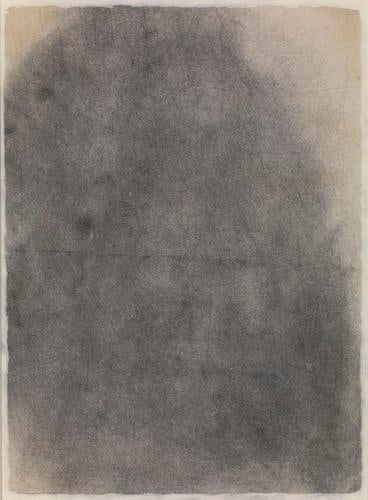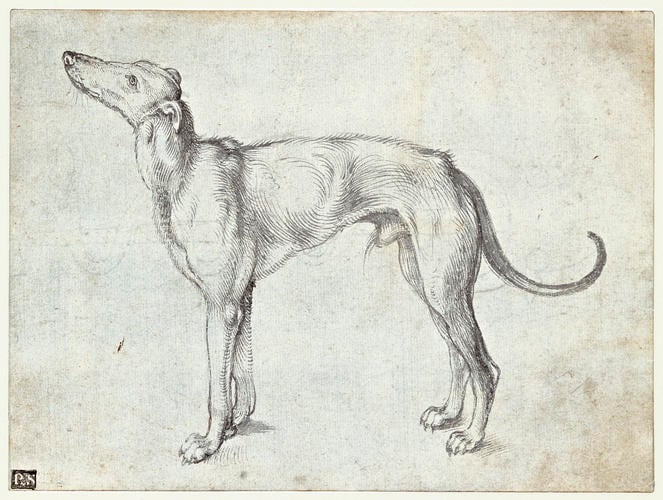A greyhound c.1500-1
Brush and ink, the outlines indented with a stylus | 14.8 x 19.8 cm (sheet of paper) | RCIN 912177

Albrecht Dürer (1471-1528)
A greyhound c.1500-1


-
The drawing corresponds, in reverse, with one of the dogs in Dürer’s large engraving of the Vision of St Eustace, executed around 1501. The handling of the elegant brushmarks is deceptively simple; as an engraver, Dürer knew how to use swelling and tapering lines to convey the dog’s wiry yet muscular form and coarse coat. The reverse of the sheet has been rubbed with black chalk or charcoal, and the outlines of the drawing traced around with a stylus to effect a ‘carbon copy’ onto another sheet. But the correspondence between drawing and print is not exact, for the dog here is some sixty per cent larger than that in the engraving, and even when the motif is scaled down the contours do not coincide, indicating that Dürer at some stage copied his own drawing freehand to reduce the size of the motif.
The drawing is one of the few at Windsor to have come from the collection of Sir Thomas Lawrence (1769-1830), who had taken advantage of the upheavals in Napoleonic Europe and the dispersals of collections such as those of Sir Joshua Reynolds (1723-92), Benjamin West (1738-1820) and, in this case Paul Sandby (1731-1809), to form one of the greatest of all private collections of drawings. Lawrence had specified in his will of 1828 that ‘My collection of genuine drawings, by the old masters, which in number and value, I know to be unequalled in Europe, and which I am fully justified in estimating, as a collection, at twenty thousand pounds, I desire may first be offered to His most gracious Majesty, King George IV at the sum of eighteen thousand pounds.’ But the King, then successively the British Museum, Sir Robert Peel and the Earl of Dudley all declined the offer, and Lawrence’s principal creditor, the dealer Samuel Woodburn, dispersed the collection at a sequence of selling exhibitions held in London between 1835 and 1838. The Dürers were part of the eighth exhibition, in May 1836, at which this drawing was described as ‘A study from nature - of a dog; this admirable drawing is executed with the pen, and is the model used for the celebrated engraving of the St Hubert, where it is introduced. Very fine’ (Woodburn 1836, no. 27; both St Eustace and St Hubert had visions of a crucifix between a stag’s antlers, and the two were often confused). Woodburn’s catalogue stated, at the end of the list of fifty drawings exhibited, that already ‘the splendid collection of drawings by Albert Durer, consisting of one hundred, has been sold for £800’. It is not known how the drawing subsequently entered the Royal Collection.
Text adapted from Holbein to Hockney: Drawings from the Royal CollectionProvenance
Paul Sandby; probably his sale, London: Christie’s, 17 March 1812 (lot 85; part); Sir Thomas Lawrence; Samuel Woodburn, by whom sold in 1836; Royal Collection by 1926
-
Creator(s)
-
Medium and techniques
Brush and ink, the outlines indented with a stylus
Measurements
14.8 x 19.8 cm (sheet of paper)
Other number(s)
RL 12177








